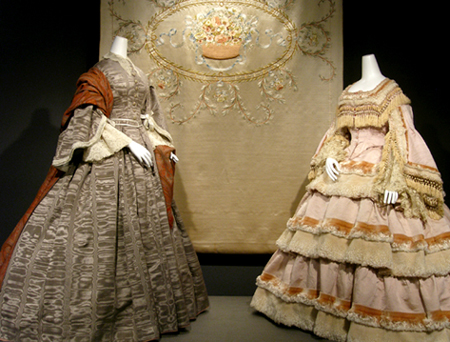 |
|
LEFT:
Afternoon dress
Grey silk moiré
Circa 1860, England
The Museum at FIT, 2006.56.3
Museum purchase
Shawl
Wool
Circa 1870, Scotland
The Museum at FIT, 78.48.4
Gift of Ethel Rabin
MIDDLE:
Furnishing Fabric
Silk and embroidery
Circa 1870, France
The Museum at FIT, 75.109.64
Gift of Mrs. William Randolph Hearst, Jr.
RIGHT:
Two-piece day dress
Dusty rose silk ottoman and silk velvet
Circa 1859, USA
The Museum at FIT, P91.23.3
Museum purchase
| |
As industrialization
fueled the proliferation of ready-made goods, members of the
socio-economic elite increasingly emphasized the importance of
technically refined, custom-made apparel. Luxury dressmaking often
involved matching complicated patterns like that of this fine moiré
or “watered” silk.
The fashion for full skirts worn over a crinoline led to a demand
for large, square shawls. By the end of the century, however, shawls
were losing their elite cachet, as new production methods were
making them less expensive.
The extravagance of 19th-century luxury is well illustrated by this
silk wall panel that juxtaposes grand scale and intricate
embroidery. The pursuit by wealthy Europeans of detailed perfection
in their surroundings gave rise to the term “interior decoration.”
The unusual fabric of this velvet skirt is comprised of graduated
sizes of cut and uncut pile. According to the sociologist Thorstein
Veblen, the class structure of modern capitalist society required a
“progressively refined discrimination” to discern subtle differences
and novelties in dress. | |